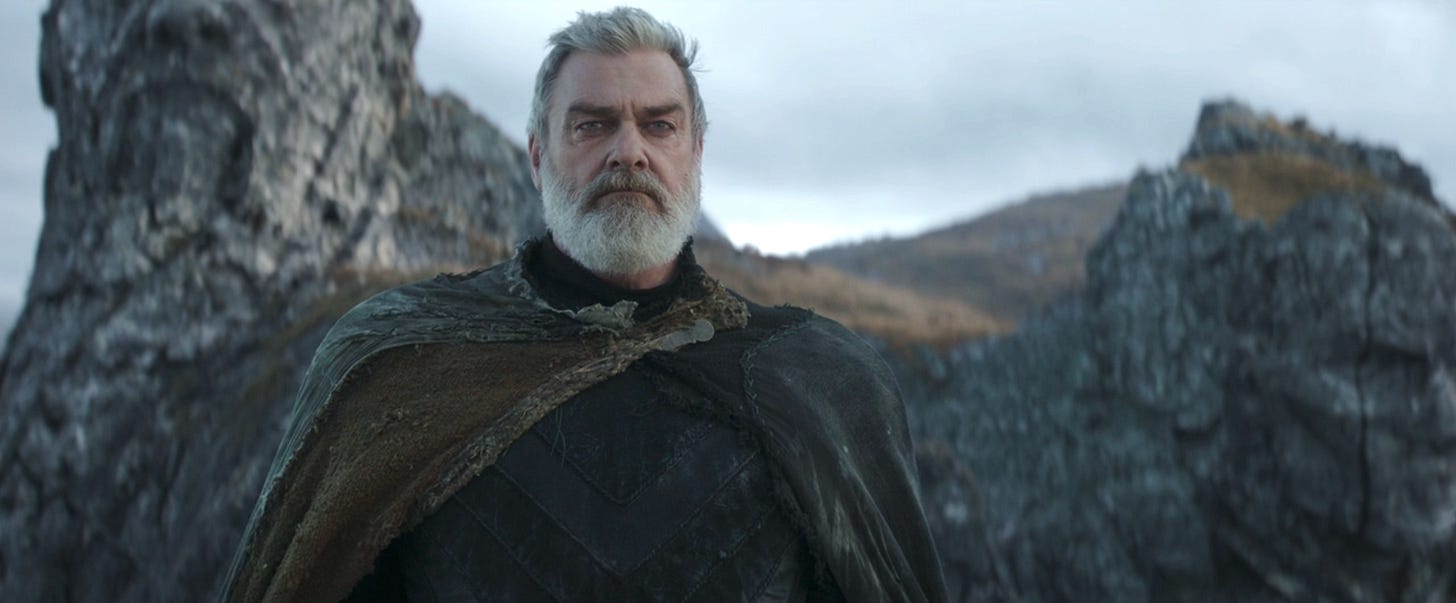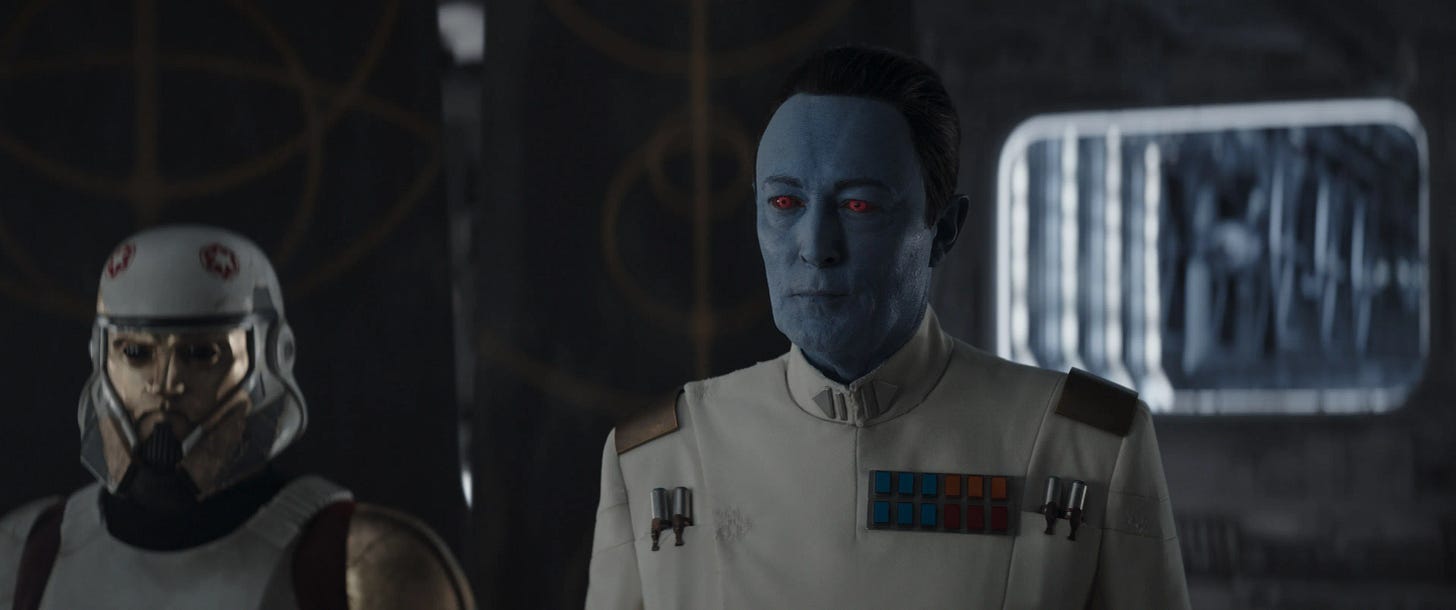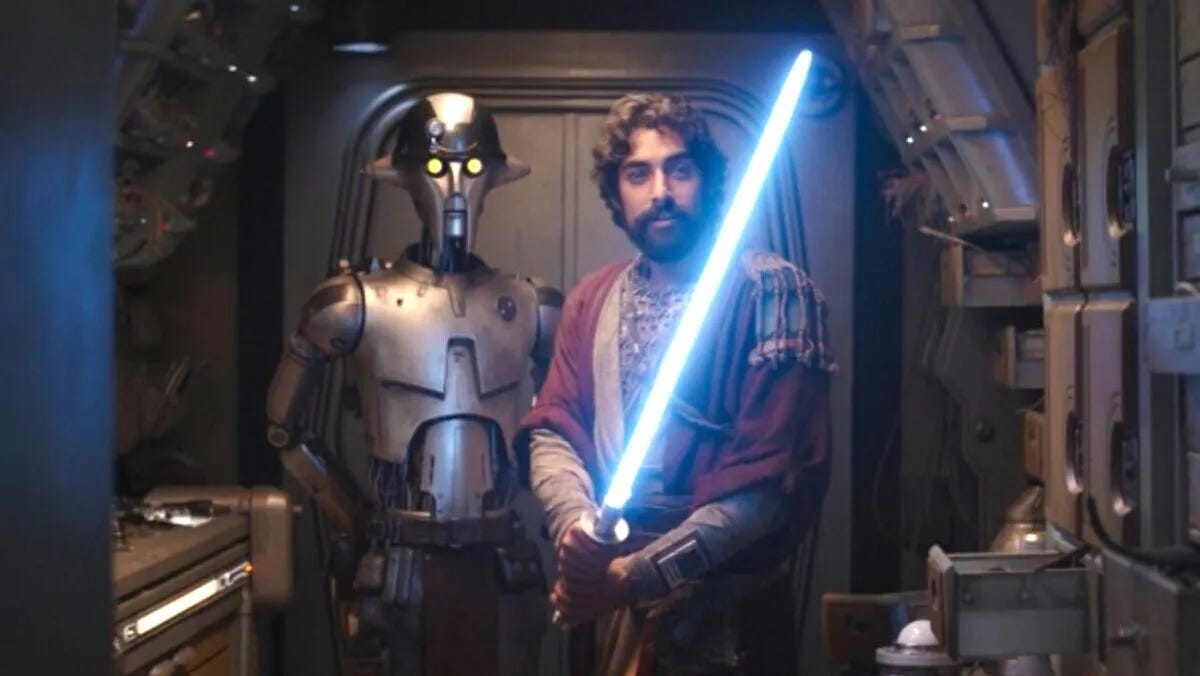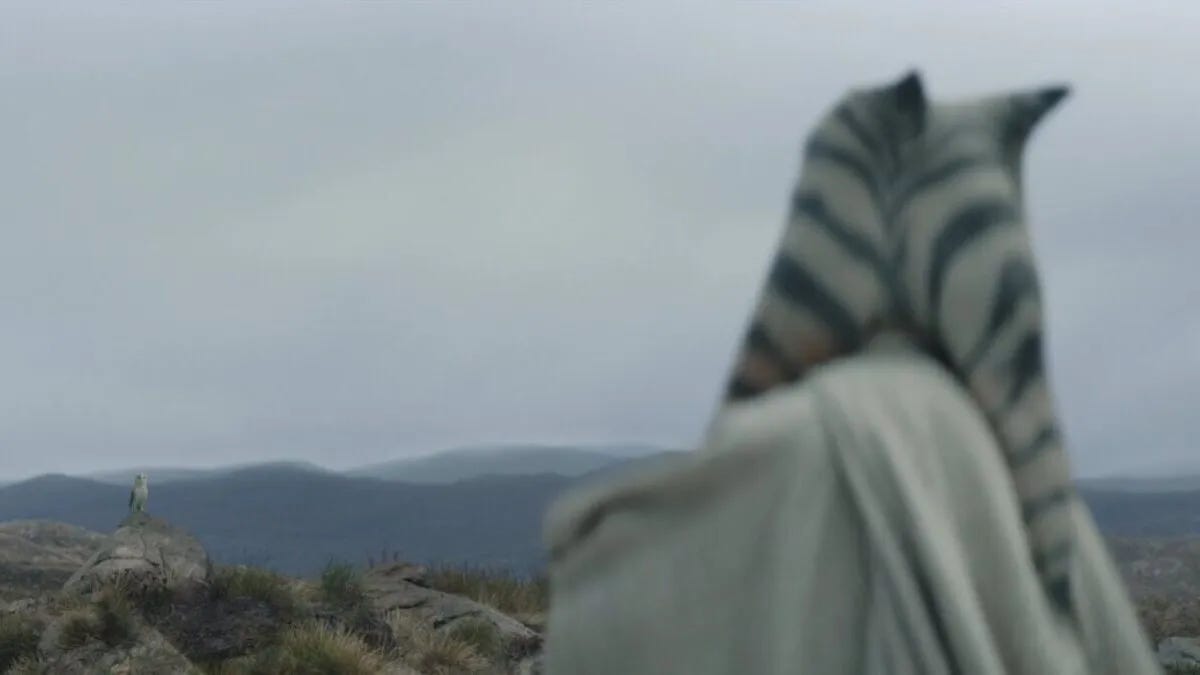Ahsoka Season Finale sharpens its focus, at a cost.
Like a good apprentice, I'd like to learn from its failures.
The Short Take:
A finale that unto itself reaches amazing heights, but in the context of the broader season leaves some key storylines hanging. We get satisfying character resolution at the expense of (some) plot resolution.
[SPOILER ALERT: It’s a finale.]
Image Credit: IGN
The Long Take:
It wasn’t enough.
His tattered, ashen cape billowing in the winds of Peridea, Baylan Skoll steps out onto a precipice and gazes upon the land of dreams and madness. The hills climb, crest, and fall, seemingly endless. The frame widens to reveal what remains of three mountain-sized statues — mysterious ancient ruins. One of them ominously points ahead. In the same direction, Baylan’s stare pierces into the unknown. He says nothing.
This is last time we will ever see actor Ray Stevenson play Baylan Skoll.
And it wasn’t enough.
Image Credit: Men’s Health
The most consistent criticism the Ahsoka Season 1 Finale has received is that two new, complex, and intriguing characters, Baylan Skoll and his apprentice, Shin Hati, barely get any screen time. What’s more — and this is closer to my own frustration — we don’t even get a hint of what Baylan could be searching for, going on little more than oblique references to Jedi temple fairytales in past episodes.
Reactions to the lack of development in this final hour are inherently complicated and messy. On Coffee with Kenobi this week, Dan Z admitted that his dissatisfaction with the distinct lack of resolution for Baylan’s storyline could be, at least in part, tied up in his feelings about the loss of actor Ray Stevenson, who died this past May at the age of 58. At best, Stevenson’s loss exacerbates a feeling of wanting more.
I have several potential explanations as to why Ahsoka would pause Baylan’s story here, at the very beginning of his journey on Peridea rather than in the midst of it. You’ll have to listen to Coffee With Kenobi to hear my take on Peridea as Narnia and Ahsoka, Sabine, Baylan, and Shin as the four Pevensie children. Here, I’ll focus on production considerations and narrative constraints. With only 8 episodes in the entire season, this finale needed to focus on the central conflict between Ahsoka and Thrawn, and the question of whether or not Hera’s worst fears would be confirmed if he escaped back to the primary galaxy. Imagine if we had taken time away from the final battle (which was spectacular) and left the question of whether or not Thrawn would return open. (As well as who would hitch a ride along with him.) Fans would be rioting in the proverbial streets.
The trend in Disney+ series, presumably to keep production costs down or allow for a higher budget per episode, has been shorter seasons. Each season of The Mandalorian has been 8 episodes, The Book of Boba Fett was 7, Obi-Wan Kenobi has the lowest number at 6, and Andor has the highest number at 12. I think it’s no coincidence that the most acclaimed series on this list, which told a story viewers thought was complete and satisfying, has the most episodes.
For Star Wars in particular, the move to Disney+ has largely replaced feature films. In many ways, this creates pressure to tell a grand, cinematic story, worthy of a theatrical release, but in a serialized format for a smaller screen. I haven’t quite pinpointed what fallout or growing pains this has induced, but there’s definitely something happening in these series that is not quite television and not quite film. It’s a strange hybrid genre called a streaming series, upon which we cannot neatly map traditional notions of storytelling for television. So I’m not saying we have to revert to more of a network television model, with 22 or more episodes in a season. But it’s clear that for a story of the scope and scale of Ahsoka, we could have easily gotten value out of more than 8.
The MCU-ification of film and television could be the primary catalyst for these medium-bending growing pains. Dave Filoni and Jon Favreau have both indicated that they’re inspired by the MCU and Game of Thrones (which usually had 10 episodes per season, by the way) because both of those franchises have the ability to tell seemingly separate stories with different characters in different far-off places that gradually work their way towards a convergence. In the MCU, that convergence was Avengers: Endgame. In Game of Thrones, it was the war against the Night King and the White Walkers. Thrones would often end seasons with all of the Stark children dispersed across the Seven Kingdoms and beyond. But every so often their paths would cross as the series moved from the political infighting story to the unite against a common enemy story.
Baylan and Shin’s story remains suspended, presumably under the assumption that it will resume in a second season. I hope the creators behind the series can recast Ray Stevenson — as painful as that will be and as difficult as that will be for whoever steps into the role — so that we can see his story play out as originally intended. But that complication aside, I think the assumption this series operates under here is that it is telling a much bigger story than this one season and even this one series.
Ahsoka, after all, allegedly has to sync up with the rest of the “Mando-verse” in time for an Avengers-style film. And, as I’ve said before, I am incredibly excited for this if they can pull it off. During all of the “Sabine cracks open her chi and learns how to use the Force” scenes, I kept thinking how cool it will be when someday she meets up with Grogu and can swap notes on how hard it is to be a Mandalorian and a Jedi.
Still, I have concerns, and this is not the first time I have raised concerns about this “Rebels, assemble!” approach to Star Wars storytelling. My review of the finale of The Mandalorian Season 3 worried whether the lack of clarity in where that season was going resulted from prioritizing the union of all these disparate groups of Mandalorians to defend Mandalore from Moff Gideon, of prioritizing the Endgame moment above the story that gets us there. Only later will we really know if the Season 1 finale of Ahsoka makes more sense as a stepping stone towards a deep bench showdown against Thrawn on the big screen than it does as the endpoint of an isolated story arc. This is me at my most cynical, in case you were wondering.
Image Credit: Variety
Out of all the reasons to leave plot lines like Baylan and Shin’s unresolved, though, the simplest one may prevail: this series is called Ahsoka and therefore should primarily focus on that titular character. Through the lens of Ahsoka’s arc this season, as a wayward ex-Jedi and apprentice to Anakin Skywalker, who, since fans last saw him in animation, became Darth Vader and ultimately died in Return of the Jedi, marking what is perhaps the greatest redemption arc in all of genre storytelling — *takes deep gasp of air.* As I was saying, once I consider this finale through the lens of what’s going on with Ahsoka as a character and everything in her emotional orbit, this episode gave us a great deal of development and resolution.
This finale tells us that the story the season has been trying to tell all along is one of masters and apprentices, and, centrally, Ahsoka being Anakin’s apprentice and then struggling to take on an apprentice of her own, Sabine. When we begin the season, Ahsoka and Sabine are estranged, and as the season progresses, Ahsoka faces her guilt and fear about Anakin and his lasting legacy as Darth Vader in order to become a better master to Sabine. She moves from cold rigidity in Part 1 to warm acceptance in Part 8. She may not have made the same choice as Sabine, but she recognizes that to be a good master, she still needs to support Sabine’s choice and, rather than dwell on the consequences, becoming angry and frustrated, she must trust in the Force and deal with situations as they come. I have heard some critics, such as The Midnight Boys on The Ringer-Verse, say that the conversation between Ahsoka and Sabine felt weak or uneventful. I respectfully disagree.
Their conversation gave us all we needed to know to appreciate how far Ahsoka has come. Sabine asks, “You’re not mad?”, with surprise in her voice. Ahsoka replies with a moment of identification, trying to relate to Sabine’s experience: “Over the years, I’ve made my share of difficult choices. Often, no one understood my reasons.” Then her words turn to Anakin as she says, “Except my master…He always stood by me. Even when no one else did. That’s why no matter what happens next, I’m going to be here for you.” Ahsoka is only able to say this to Sabine because she has, over the course of the season, realized that the evil of Darth Vader does not erase the good of Anakin Skywalker. That he was still a “good master” (a phrase she explicitly uses in Part 7) who always supported her. And that it’s okay for her to pass down his teachings to Sabine, who may have, as we learn here, had her own dangerous brush with the Dark Side.
Here is the payoff of all the varied references to Anakin, including the World Between Worlds flashbacks from The Clone Wars and the training video Ahsoka watches on the shuttle. Most notably and vocally in this episode, Thrawn invokes Anakin Skywalker, both as a way of explaining his strategy (“There will be no negotiating with the apprentice of Anakin Skywalker”) and as a way to taunt Ahsoka (“How similar will you become?”). While he does get just enough of reaction out of Ahsoka to imply that she would relish in a rematch someday, I think that he ultimately fails in getting in her head because of all the healing that has come before this episode. I can see so many lines from the Anakin scenes in Part 5 coming to roost here, but, just as an example, Anakin says “soon you’ll be everything I am” and that she’s more than her war-torn past and more than his fall because, as he says, “You’re more than that. I’m more than that.” To me, the narrative through-line of this season couldn’t be clearer.
Image Credit: We Got This Covered
The thesis of this series stated more explicitly and more broadly, though, comes from Huyang. When Ezra asks him how old he is, the erudite yet sassy droid says, “Old enough to know that the relationship between a master and an apprentice is as challenging as it is meaningful.” Sabine and Ahsoka’s relationship may be challenging, but that doesn’t mean it can’t also be meaningful if they can work out their issues. We see that in action in this episode, in fact. Whereas they had trouble being on the same side and staying together, not listening to Huyang’s advice in Part 4, the end of this episode shows them getting it right this time: Ahsoka says she’ll always have Sabine’s back and tries to do everything she can to help get Ezra home, and Sabine, in turn, gives up the one thing she cared about most in the world — reuniting with Ezra — to stand by Ahsoka, knowingly stranding herself on Peridea.
Star Wars, of course, has always been about the student-teacher relationship to which Huyang refers. Ahsoka herself says to Luke in The Mandalo — I mean, The Book of Boba Fett, “Sometimes the student guides the master.” She learns to take her own advice in this series. A good teacher cannot didactically hand down knowledge; they must meet their student where they are, take their identity and experience into account and let them actively participate in their own learning. It’s what would happen if Thrawn used his tactical powers for good — just in the way he must take who his opponent is into his strategy, so too must a teacher take into account who their student is and how their student best learns in order to effectively teach them. In education, this is commonly referred to as accommodating different learning styles. Even though I am lucky enough to teach courses capped at 19 students, I will never have the luxury of the Jedi model of one teacher per student. As such, I try to design an inclusive classroom, one that will allow students to draw from their own expertise, experience, and interests, as much as possible.
We actually get many versions of this teacher and student relationship throughout the episode. Kanan and Ezra’s seems to be upheld as a sublime ideal; even long after his death, we can see Kanan’s positive influence on his apprentice, who ends up building a lightsaber with the only other copy of the part a young Caleb Dume (Kanan’s given name) used to make his. Furthering my earlier point about taking the specific student into account when trying to teach them, Huyang can really only help Ezra once he can use his knowledge of Kanan as context through which to understand Ezra’s “method.” And, as I discussed earlier, Ahsoka and Anakin’s relationship may seem like a failure on paper, as she left the Order and he became Darth Vader, but this series has worked hard to establish that despite the way things turned out, their bond as student and teacher was pure.
We also get less functional relationships, and I’m not even talking about Sabine and Ahsoka.
pointed out to me that in The Mandalorian, Ahsoka refers to Thrawn as Morgan Elsbeth’s “master.” And if we view their relationship as master and apprentice, it becomes clear that Thrawn, unsurprisingly, does not care about Morgan at all and is more than happy to sacrifice her, ordering her to duel Ahsoka as he skips off to another galaxy. And that brings us back to Baylan and Shin, the final master and apprentice relationship I have not yet mentioned. This one is, fittingly, a little murkier, as some viewers and critics were confused last week by Baylan saying that he and Shin should part ways — so he can pursue his mission for the greater good and so she can pursue her ambition of rising to power in the coming Empire. I saw this as wise and understanding potentially, but can also easily see the alternative reading of it as neglectful or uncaring.If we see their parting as the latter, then the final scenes, of Baylan standing on the edge of the cliff, searching for some ancient power, and Shin raising her lightsaber to make her bid as the new leader of the Peridean marauders, act as insult to injury. Would the marauders, under Shin’s leadership, then rejoin Baylan to provide muscle to his new world order? Or are they really doing their own thing? Again, I fully acknowledge that not knowing here does more harm than good. After such an ambiguous development in their relationship last episode, generating even more open questions with where they leave off this week would be understandably frustrating for many. There’s a difference between leaving us in suspense and leaving us in a state of confusion.
At the start of this review, I said that the final scene of Baylan was not enough. That it didn’t tell us anything about what he was looking for and where he was going. This is not entirely true for viewers who have seen the Mortis arc of The Clone Wars animated series I flagged as potentially important earlier in the season. (Aren’t you proud of me for making it this far without shouting “MORTIS!” or “MORAI!” at you?) I’m not going to rehash the events of the arc here, but if you haven’t read my past reviews, the ruins we see behind Baylan are ancient Force beings or “Mortis gods” called The Father, The Son, and The Daughter. The Father’s role was to keep The Son, who skewed towards the Dark Side, and The Daughter, who skewed toward the Light Side, in balance. The implication was, at least for me, that this balance somehow affected the balance in the Force in the wider galaxy. I don’t think it’s a coincidence that the most wrecked statue, missing a head, is The Daughter on the left; she died and transferred her life essence, force, spirit, etc. to a young Ahsoka. This could very well have made Ahsoka’s destiny to restore balance to The Force in the most fundamental, deeply mythological way.
Image Credit: Polygon
Now that the Mortis gods are on the table, and now that Ahsoka’s convor guardian, Morai (whom she presumably inherited from The Daughter), is FINALLY HERE (squee!), I am downright giddy about the possibilities for the role Ahsoka might play in Baylan’s quest on Peridea and what he might learn about her and the nature of The Force in the process. I honestly thought this was too deep a cut for a series like this, and I couldn’t be happier that Dave Filoni was bold enough to incorporate this high concept, borderline esoteric mythology into a live action series.
Image Credit: We Got This Covered
Even if you’re excited about more Star Wars myth, like me, and even if you’re buying my, “but the show is supposed to be about Ahsoka” explanation, the disappointment in the sidelining of Baylan and Shin in this finale is there and it’s real. But what can this teach us or tell us about Star Wars storytelling going forward, though? How can, as Yoda says to Luke in The Last Jedi, teacher be our failure?
I think the response to Baylan and Shin and their marginalization in this finale is a testament to a thirst for new characters in new stories as much as, perhaps more so, than characters with which we are already familiar. (I also need to credit
for giving me this idea.) These are two characters whose histories are still shrouded in mystery. We know Baylan trained at the Jedi temple and was a General in The Clone Wars, but we do not yet know exactly what happened to him there and then. We don’t yet know how he met Shin. We don’t know even where Shin came from. And with a series that increasingly requires prior knowledge or at least rewards those with prior knowledge of previously introduced characters, a lot of the interest of viewers coming in from the outside will gravitate towards characters who are new to everyone.I do not want anyone to mistake my critique of the Ahsoka finale as a reflection of my attitude towards the series as a whole. I have cherished all the time we’ve spent with Ahsoka and other characters I love, and I am extremely excited for how Dave Filoni continues to ground his storytelling in what makes Star Wars Star Wars while also breaking new ground and pushing the franchise forward. If writing these reviews every week has taught me anything, it’s that Dave Filoni has grown beyond his own master, George Lucas, by bringing his fantasy world building sensibilities — inspired by J.R.R. Tolkien, C.S. Lewis, and Hayao Miyazaki — to a galaxy far, far away.
No, make that TWO galaxies, far, far away.










Thank you for yet another layered, insightful take on a series I feel has proven to be polarizing. I am really hoping Ahsoka gets a second season and puts to rest people's concerns about the lack of resolution. I def-ly wonder why none of the Star Wars series other than Andor have had more of a proper length 12-episode season. 8, imo, is just too short.
Also, your note about the hybrid form of a streaming series and an episodic series reminded me of an article by Emily St. James. I actually haven't read it because it's for paying subscribers only but a hybrid storytelling form looks to be something that's def-ly happening in shows like Foundation and Andor: https://episodes.ghost.io/foundation-episodic-storytelling-last-of-us-dead-ringers-andor/
Great recap. Your enthusiasm is infectious. :)
One thing you said really stood out to me. "But it’s clear that for a story of the scope and scale of Ahsoka, we could have easily gotten value out of more than 8." I agree. I also think they could've been more judicious with the screen time they did have. Instead, Ahsoka is in the murky middle ground of having not been long enough because it didn't do enough.
Also, Baylan forever. :)